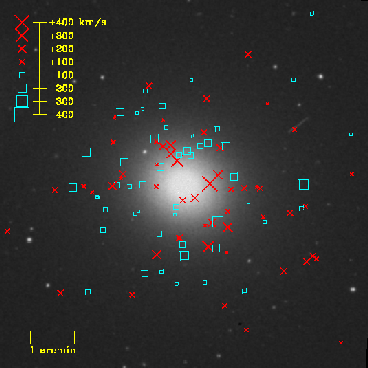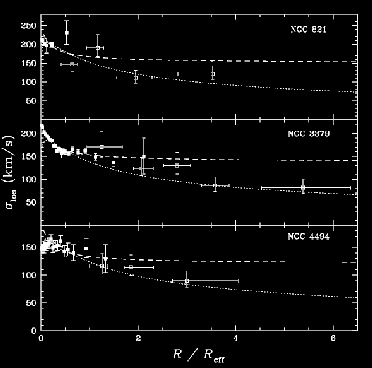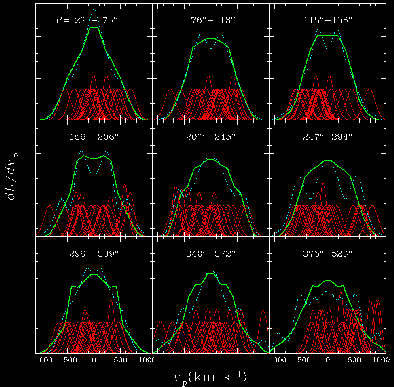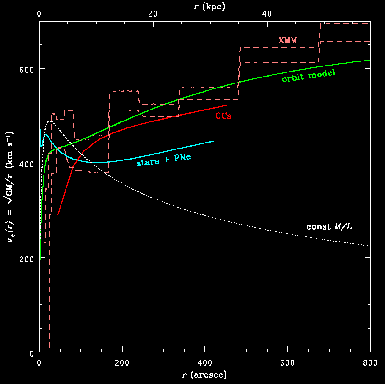Research Summary:
Galaxy Halos
Aaron J. Romanowsky
(as of August 2003)
PDF version
1. Introduction
Galaxies are a linchpin in our understanding of the history
of the universe---bridging
the physics of star formation on small scales with structure
formation on large scales,
and encompassing the evolution of matter from
early times to the present day.
As advancing instrumentation probes galaxies' basic properties
(morphologies, star formation rates, etc.)
at higher and higher redshifts,
it is vital to ascertain the detailed properties of nearby galaxies,
delving for the fossil imprints of their formational processes.
While several programmes have been studying the dynamics of the central
regions of nearby galaxies1,2,3,
an under-explored arena is galaxies' haloes---the
transitional regions where dark matter is presumed to dominate,
and where the complicating effects of dissipation
are minimal.
Some of the key halo properties to be established
are the distributions of mass,
of angular momentum,
and of stellar orbit structure,
as well as any substructure left over from accretion
and merging events.
Most of these properties are relatively well established
for spiral galaxies
but quite unknown for early-type galaxies (ellipticals and S0s),
which do not have on hand such simple dynamical tracers
as spirals' cold gas disks.
There are several main lines of inquiry into the
characteristics of early-type haloes: gravitational lensing,
X-ray emitting gas, globular clusters, and planetary nebulae.
Each of these approaches can probe a different set of halo properties,
and each carries its own set of systematic uncertainties.
With advances underway in the exploitation of all these techniques,
we are now on the cusp of major strides forward in our knowledge
of early-type haloes---and ultimately, of galaxy formation.
Having used all of the above methods to investigate galaxy haloes,
I am continuing to take a multi-pronged approach to this subject,
as detailed below.
2. Planetary nebulae
Planetary nebulae (PNe) are potentially the single most useful tracer
in early-type haloes, since they are representative of the overall stellar population,
and thus can probe all of the halo properties mentioned above.
The observational appeal of PNe springs from the strength of their emission in
the [O III] line at 5007 Å, which when isolated
allows them to be observed in galaxies to large distances and at arbitrarily large radii.
There are hundreds to thousands of PNe in the brightest decade around an
early-type galaxy---suitable numbers for dynamical studies.
Unfortunately, PN kinematical observations have proven
too problematic with standard instrumentation and techniques.
To address this shortfall, our collaboration has designed and commissioned
a purpose-built instrument:
the Planetary Nebula Spectrograph
(PN.S)4,
which has proved to be a major advance in this field.
The PN.S employs a variation of slitless spectroscopy termed
counter-dispersed imaging (CDI). In this technique, an image is taken of a galaxy field
through a narrow-band filter with a dispersing element but no slit;
the continua of stars in the field show up as long spectral segments
(truncated by the filter bandpass), while emission-line objects such as PNe appear as
point sources. Rotating the dispersion direction 180° between two exposures allows one to
find a PN's line-of-sight velocity by measuring its positional shift;
thus, one both detects and finds velocities for PNe in a single observing run
(see Figure 1, left)---a major improvement in terms of efficiency and simplicity over traditional methods.


Figure 1.
Left:
Line-of-sight velocities of planetary nebulae (PNe) around NGC~3379, relative
to the systemic velocity.
Red crosses
represent receding velocities,
and blue boxes are
approaching,
where the symbol sizes indicate the velocity magnitudes.
Right:
Line-of-sight velocity dispersion profiles for three elliptical galaxies,
as a function of effective radius.
Open points show planetary nebula data (from PN.S), solid points show
long-slit stellar data5,6,7.
Predictions of simple isotropic models are shown for comparison:
a singular isothermal halo (dashed lines) and a constant mass-to-light ratio ga
laxy (dotted lines).
The primary programme of the PN.S is to study a representative sample of 12 giant, round ellipticals.
We have so far obtained 100--200 PN velocities in each of a few galaxies.
The early results are already very intriguing.
For the three intermediate-luminosity ellipticals NGC 821, NGC 3379 and NGC 4494,
we find a stellar velocity dispersion profile that declines at large radii (Fig. 1, right),
in contrast to the constant profiles that one
would expect based on our knowledge of spiral galaxies8
and X-ray-bright ellipticals9.
Detailed dynamical analysis (see below) of NGC~3379 determines that its total
B-band mass-to-light ratio $\Upsilon_B$ inside 5 Reff
(effective radii) is
7\pm1 $\Upsilon_{B,\odot}$, which is consistent with the properties of the stellar population alone.
The results for the other two galaxies, as well as another from the literature10,
are similar, thus implying that many ordinary ellipticals contain
little or no dark matter
inside these radii11.
Possible explanations are that these galaxies have had their haloes inexplicably stripped away,
or that the missing dark matter lies at still larger radii---requiring
more diffuse haloes than predicted by simulations of galaxy formation12.
A further result from the PN.S survey and from other PN studies (below)
is that the outer parts of ellipticals show weak rotation (v/\sigma ~ 0.1--0.3).
But if ellipticals form via the mergers of spiral galaxies as commonly supposed,
they should show rapid rotation in their outer parts (v/\sigma ~ 1 ; Refs. 13,14).
We will see if this finding, as well as the dark matter results above,
may be supported in a broad range of elliptical galaxies
upon the completion of the PN.S primary programme---which
has been granted long term status from the UK at the
4.2-m William Herschel Telescope (WHT) on La Palma.
Another PN.S project is the in-depth study of the other giant Local Group spiral, M31.
We have recently made a high-quality survey of ~3 square degrees in this galaxy,
obtaining velocities of ~2500 PNe,
and an upcoming survey will probe further out into its halo and along its disk major axis.
From these data, we are not only reconstructing the dynamical structure of
the stellar disk, but also probing the mass distribution in the inner halo,
whose total mass has been found surprisingly to be no larger than that of the Milky Way15.
Further, we are examining the dynamics of the satellite galaxies M32 and M110 and
looking for kinematical signatures of any interactions between them, M31, and the
faint stellar streamers photometrically discovered in M31's halo16,17.
CDI methods may also be adapted to improve existing standard spectroscopic
methods. One of the obstacles to obtaining PN kinematics with follow-up spectroscopy
has been unreliable astrometry in the original survey images, which is unfortunate
because of the large quantity of such surveys already in existence.
We have developed a new technique, masked CDI,
whereby a normal multi-slit mask is used to observe a sample of PNe, but
the slits are enlarged to a width of 4", ensuring that the PN spectra will be acquired.
A pair of dispersed images is taken with opposite dispersion directions, and then
the PN velocities can be deduced without any need to know the original positions
accurately---the astrometric errors cancel out.
Using the Mask eXchange Unit of FORS2 at the 8-m Very Large Telescope (VLT),
we have obtained many PN velocities around the giant ellipticals M87 and M49
(~200 and ~100, respectively).
We hope to continue using masked CDI to acquire more velocities around these and
several other galaxies.
3. Globular clusters
Globular clusters (GCs) are not only useful as abundant
kinematical tracers of halo mass, but are interesting in their own right
because as some of the oldest known structures in the universe,
they are witnesses to most of the long history of galaxy formation.
Many galaxies are now known to have bimodal globular cluster systems, with the
GC subsets broadly characterizable by distinct spatial distributions, kinematics, ages
and metallicities18,19.
Thus, there have been at least two universal modes of GC formation
(with a relative importance that varies from galaxy to galaxy)---modes
that likely are deeply connected to distinct evolutionary phases in
the host galaxies.
One of the fundamental ways of discerning these connections
is by determining the detailed dynamical structure of the GC subsystems in
at least a few archetypal galaxies.
With the advent of new powerful multi-object spectrographs
on large telescopes,
it is now possible to efficiently obtain extensive GC kinematical data
in a large sample of galaxies, and so this long latent field is now entering its prime.
M87 is one of the best studied galaxies, boasting ~300 GCs
with published line-of-sight velocities20.
The GC population is distinctly bimodal, with the metal-rich GCs
probably on more radial orbits than the metal-poor GCs;
in the outer parts,
both populations show a large rotation of 200--300 km s-1---thought
to be a signature of a dissipationless major merger21.
Our analysis of the PN velocities (above) indicates that the galaxy's
halo stars rotate much more slowly
( 80 km s-1).
This is consistent with theories of galaxy spin-up via accretion
events,
and thus the major merger scenario no longer seems required.
Also, the halo stars are on preferentially circular orbits,
and so resemble more the metal-poor GCs in orbit
structure---in contrast to all the currently prevailing theories,
in which the stars should be strongly associated
with the metal-rich GCs22,23.
80 km s-1).
This is consistent with theories of galaxy spin-up via accretion
events,
and thus the major merger scenario no longer seems required.
Also, the halo stars are on preferentially circular orbits,
and so resemble more the metal-poor GCs in orbit
structure---in contrast to all the currently prevailing theories,
in which the stars should be strongly associated
with the metal-rich GCs22,23.
Like M87, M49 hosts a population of thousands of GCs, and
263 velocity measurements have been published24,25.
These indicate GC dynamics markedly different from the case of M87,
so further study is warranted.
Based upon wide-field multi-color photometry of M49, we have performed
a spectroscopic follow-up using the WYFFOS/AF2 multi-fibre spectrograph
at the WHT,
yielding spectra for ~70 GCs at very large radii
(4--10 Reff ; Ref. 26);
and we have been granted time at the Very Large Telescope with the FLAMES/GIRAFFE
multi-fibre spectrograph to further expand this data set
by ~200 GCs.
Once analysed in combination with the PN data, these
will provide excellent constraints on the orbit structure and dark matter
distribution in the galaxy's halo.
4. Dynamical analyses
As large data sets of PN and GC velocities become available,
advances in modelling methods are required
in order to make constraints on the galaxy properties that are as
rigorous and exploitative of the data as possible.
In particular, one must allow for the systematic uncertainty in the distribution of orbit types,
and make use of the higher-order velocity moment information implicit in
the discrete measurements. To this end, we have developed
an extension of the now established approach of orbit modelling27.
We start with an assumed functional form for the galaxy's gravitational potential,
and build within it a library of different orbit types, representing stars or GCs;
their distribution function is then fully nonparametric.
The model is projected onto a number of observables, and fitted to the data
(including the discrete velocities) using maximum likelihood techniques (see Fig. 2, left).
Different mass normalizations and functional forms for the potential are then
tested for the best statistical fit. We have applied our models to M87,
fitting 234 GC velocities in combination with a limited amount of integrated-light stellar data.
We find a massive dark halo with a radial profile remarkably consistent
over the region of overlap with that found using X-ray data28
(see Fig. 2, right)---attesting
to the reliability of both approaches.
The SAURON team has developed complementary techniques for their studies of the inner parts of
early-type galaxies2,
and I plan to collaborate with them on a combined analysis of
our joint data sets with a high degree of generality---probing
these galaxies' dynamics from central black hole to outer dark halo.


Figure 2.
Orbit models of M87.
Left: Line-of-sight velocity distributions (LOSVDs)
for the globular cluster system,
in nine radial bins.
The light green
lines show the best-fit singular isothermal solution,
averaged in each bin. The dark red
lines show the data (26 points in each bin).
The dotted blue lines show
simulated LOSVDs
derived from the superposition of the data in each bin.
Right:
Circular velocity profile. The Green line
shows the best-fit orbit model;
the blue and
red lines show results from
isotropic Jeans modelling,
using the stellar + PN data
and GC data, respectively.
The dashed lines show limits from
analysis of the X-ray emission28.
The dotted line shows a
constant mass-to-light ratio solution.
I have in the past used X-ray emission data to study the shapes of elliptical haloes29,
and plan to continue such work, analysing data from the new telescopes Chandra and
XMM-Newton. This is a further powerful avenue for constraining mass distributions
(directly) and stellar and GC dynamics (indirectly).
We thus have tools in hand---observational and theoretical---to plumb
the mysterious depths of galaxy haloes,
and so to elucidate many unrevealed aspects of the evolutionary history of the universe.
References
- Sarzi, M., Rix, H.-W., Shields, J. C., Rudnick, G., Ho, L. C., McIntosh, D. H.,
Filippenko, A. V., & Sargent, W. L. W. 2001, ApJ, 550, 65
- de Zeeuw, P. T., et al. 2002, MNRAS, 329, 513
- Gebhardt, K., et al. 2003, ApJ, 583, 92
- Douglas, N. G., et al. 2002, PASP, 114, 1234
- Bender, R., Saglia, R. P., & Gerhard, O. E. 1994, MNRAS, 269 , 785
- Statler, T. S., & Smecker-Hane, T. 1999, AJ, 117, 839
- Jedrzejewski, R., & Schechter, P. L. 1989, AJ, 98, 147
- Persic, M., Salucci, P., & Stel, F. 1996, MNRAS, 281, 27
- Loewenstein, M., & White, R. E., III. 1999, ApJ, 518, 50
- Méndez, R. H., et al. 2001, ApJ, 563, 135
- Romanowsky, A. J., Douglas, N. G., Arnaboldi, M., Kuijken, K., Merrifield, M. R., Napolitano, N. R., Capaccioli, M., & Freeman, K. C. 2003, Science, 301, 1696
- Wechsler, R. H., Bullock, J. S., Primack, J. R., Kravstov, A. V., & Dekel, A. 2002, 568, 52
- Barnes, J. E. 1992, ApJ, 393, 484
- Weil, M. L., & Hernquist, L. 1996, ApJ, 460, 101
- Evans, N. W., Wilkinson, M. I., Guhathakurta, P., Grebel, E. K., & Vogt, S. S. 2001, ApJ, 540, L9
- Ibata, R., Irwin, M., Lewis, G., Ferguson, A. M. N., & Tanvir, N. 2001, Nature, 412, 49
- Ferguson, A. M. N., Irwin, M. J., Ibata, R. A., Lewis, G. F., & Tanvir, N. R. 2002, AJ, 124, 1452
- Kundu, A., & Whitmore, B. C. 2001, AJ, 121, 2950
- Larsen, S. S., Brodie, J. P., Huchra, J. P., Forbes, D. A., & Grillmair, C. J. 2001, AJ, 121, 2974
- Hanes, D. A.,Côté, P., Bridges, T. J., McLaughlin, D. E., Geisler, D., Harris, G. L. H., Hesser, J. E., & Lee, M. G. 2001, ApJ, 559, 812
- Kissler-Patig, M., & Gebhardt, K. 1998, AJ, 116, 2237
- Ashman, K. M. 2003, in Extragalactic Globular Cluster Systems, ed. M. Kissler-Patig (Berlin: Springer), astro-ph/0210587
- Côté, P. 2003, in New Horizons in Globular Cluster Astronomy, ed. G. Piotto, G. Meylan, G. Djorgovski, & M. Riello (San Francisco: ASP),
astro-ph/0210582
- Zepf, S. E., Beasley, M. A., Bridges, T. J., Hanes, D. A., Sharples, R. M., Ashman, K. M., & Geisler, D. 2000, AJ, 120, 2928
- Côté P., McLaughlin, D. E., Cohen, J. G., & Blakeslee, J. P. 2003, ApJ, 591, 850
- Romanowsky, A. J., Kissler-Patig, M., Sharples, R. M., Zepf, S. E., & Rhode, K. L. 2003, in preparation
- Romanowsky, A. J., & Kochanek, C. S. 2001, ApJ, 553, 722
- Matsushita, K., Belsole, E., Finoguenov, A., & Böhringer, H. 2002, A&A, 386, 77
- Romanowsky, A. J., & Kochanek, C. S. 1998, ApJ, 493, 641
Last updated 19 September 2003



